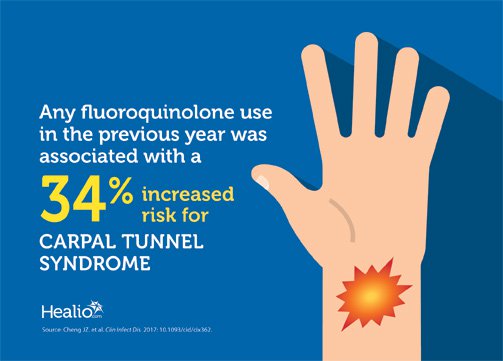Fluoroquinolone use associated with increased risk for carpal tunnel syndrome
Fluoroquinolone use was linked with an increased risk for carpal tunnel syndrome, according to researchers in Canada.
“In 2013, the FDA issued a label requirement of association between use of fluoroquinolones and neurologic conditions such as peripheral neuropathy, and musculoskeletal conditions such as tendinopathies,” Jasmine Z. Cheng, MD, of the faculty of medicine at the University of British Columbia, Vancouver, and colleagues wrote. “Given that [fluoroquinolones] are widely prescribed in North America, a potential risk of these drugs inducing carpal tunnel syndrome (CTS) should be examined in a large epidemiologic study.”
Cheng and colleagues performed a case-control study using the LifeLink health care claims database, reviewing information from about 6 million patients living in the United States. All patients were aged 15 to 60 years, and were documented in the LifeLInk database between 2006 and 2014.
For their primary analysis, the researchers identified 75,895 cases — defined as individuals with newly diagnosed idiopathic CTS — and 758,950 controls without CTS. They also included 48,533 cases with an additional nerve conduction procedure and 485,330 controls in a sensitivity analysis. Cases showed slightly higher incidences of comorbidities, including diabetes, obesity, hypothyroidism, rheumatoid arthritis and lupus compared with controls, the researchers reported.
Any fluoroquinolone use in the previous year was associated with a 34% increased risk for CTS (RR = 1.34; 95% CI, 1.31-1.37), an association that increased slightly to 36% in the sensitivity analysis (RR = 1.36; 95% CI, 1.32-1.4), according to Cheng and colleagues.
Both the primary and sensitivity analyses showed risk increases with current fluoroquinolone use (RR = 1.19; 95% CI, 1.12-1.26 for primary; RR = 1.2; 95% CI, 1.12-1.29 for sensitivity), recent use (RR = 1.32; 95% CI, 1.27-1.38 for primary; RR = 1.32; 95% CI, 1.25-1.39 for sensitivity) and past use (RR = 1.37; 95% CI, 1.34-1.41 for primary; RR = 1.41; 95% CI, 1.36-1.45 for sensitivity), the researchers wrote. Cheng and colleagues attributed this to a possible delayed response with fluoroquinolone use.
“Our study results demonstrate an increase in the risk for CTS with fluoroquinolone use,” the researchers wrote. “Patients taking these drugs should be aware of the warning of adverse side effects. Those who experienced pain, numbness, tingling and burning along median and ulnar digits may be at risk of developing CTS and should discuss their symptoms with their primary care physician.” – by Andy Polhamus
Disclosure: The researchers report no relevant financial disclosures.


